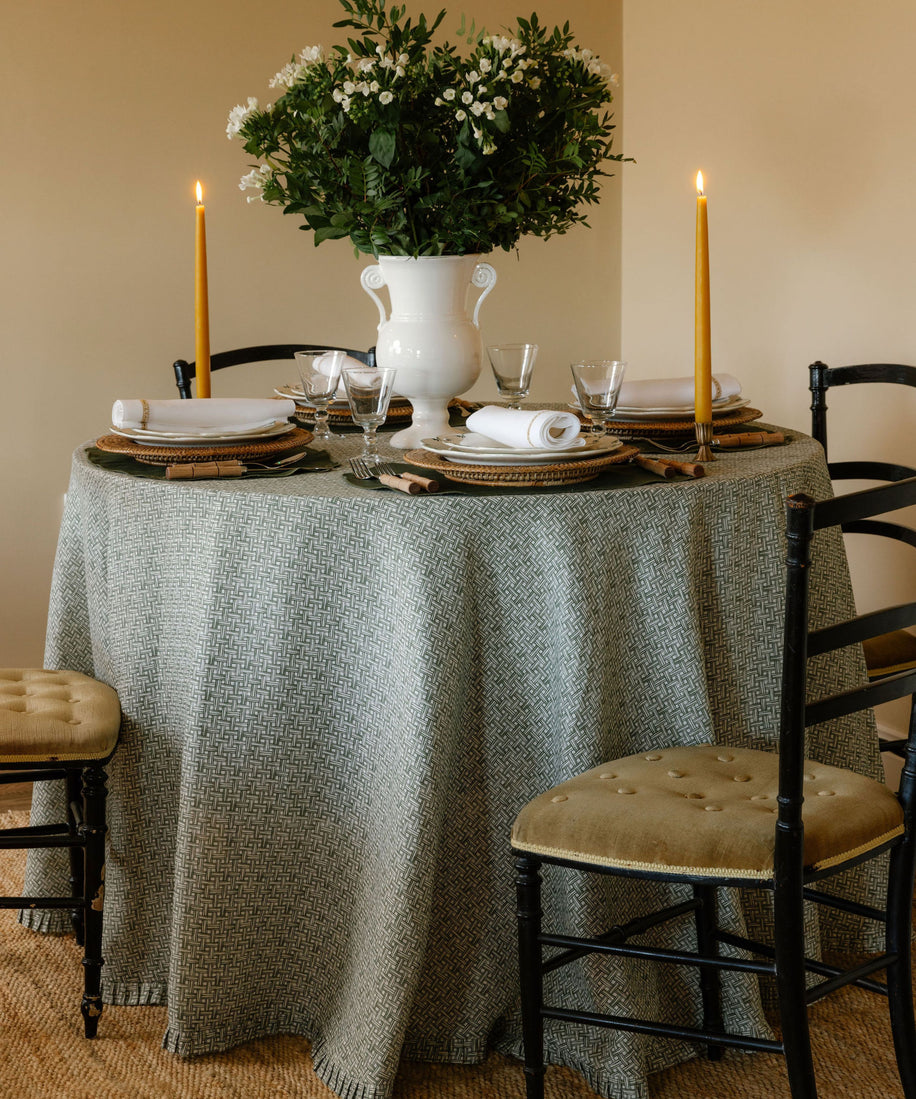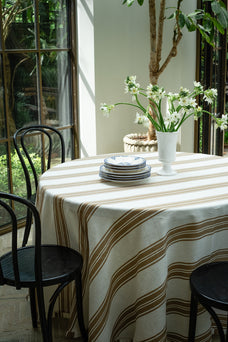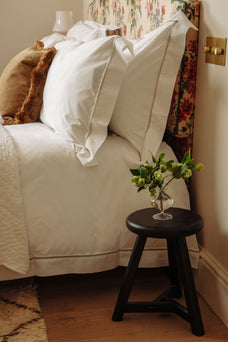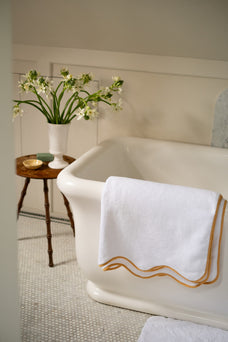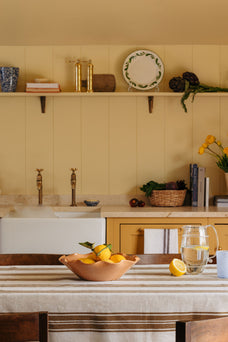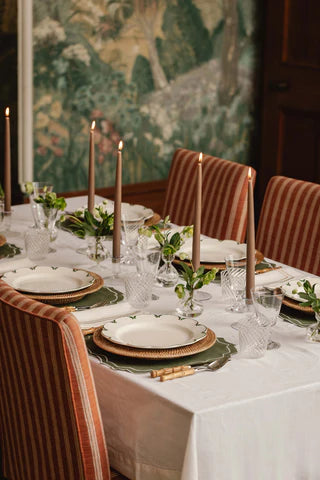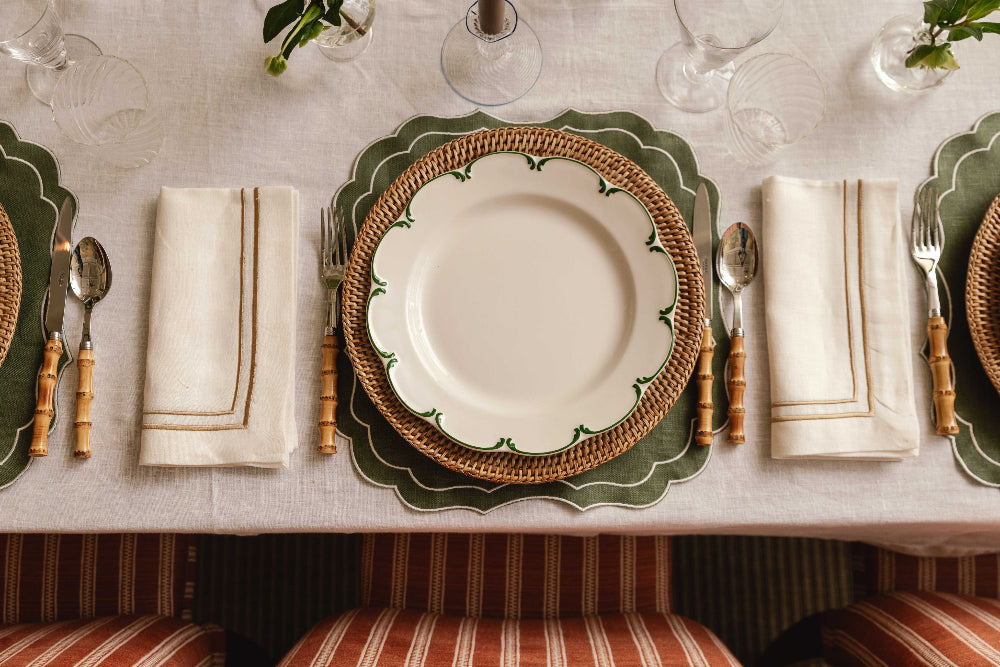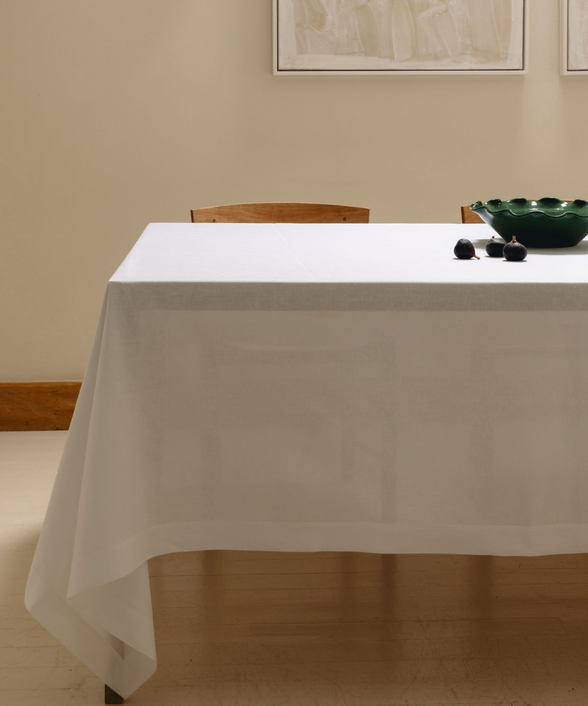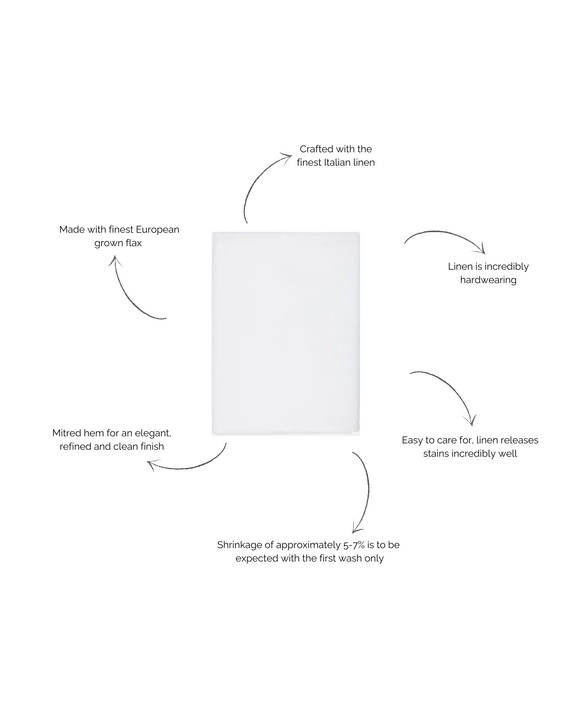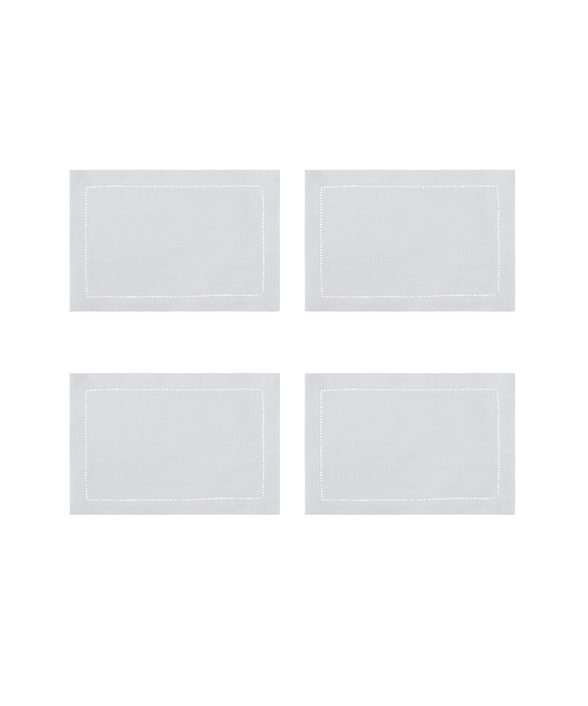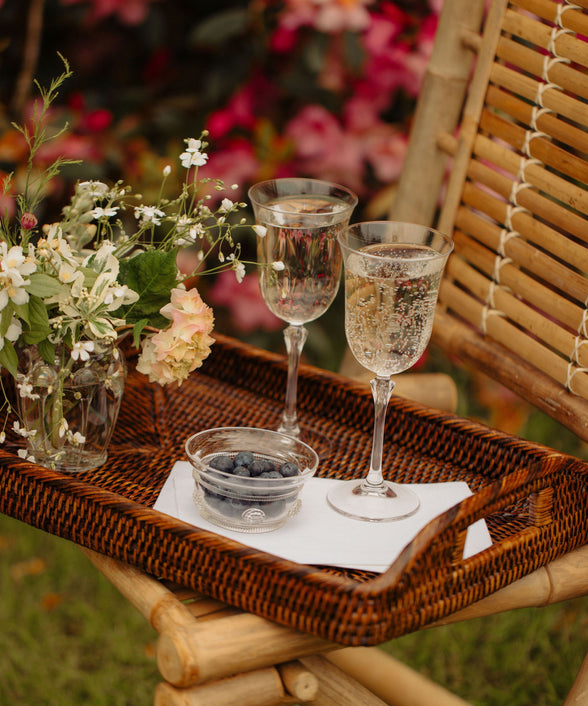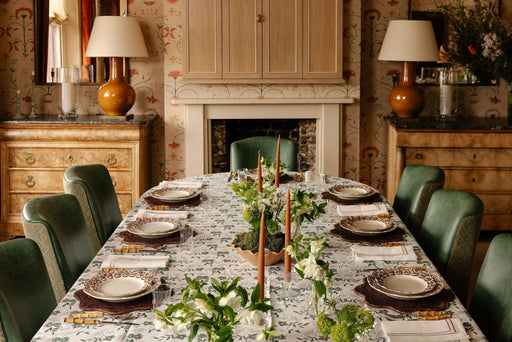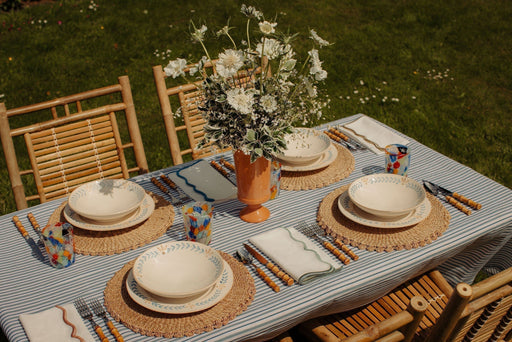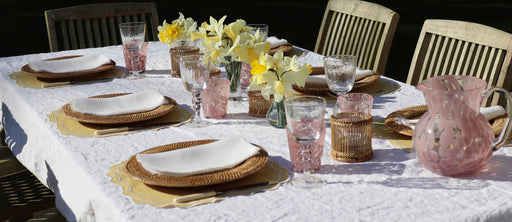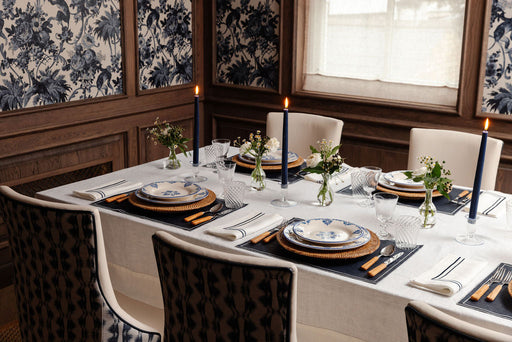Different types of table linen
There are several table linen items, both functional and decorative. Below is a description of each type and what it is for.
A linen coaster is an obvious one - a protective and possibly decorative addition for your drink to rest on, atop the dining table or other surface.
A cocktail napkin is a small napkin with several uses for when serving aperitifs. Firstly, they are a substitute for a coaster; people are often moving around or standing and therefore they can place their drink down with something to catch any condensation. They are also beneficial for keeping your hand dry in case of condensation on the glass and is helpful to mop any small spills. Finally, they are helpful to wipe hands and mouths when canapes are served. Place cocktail napkins in a pile next to where you are serving drinks, and hand them to your guests with their drink.
A dinner napkin is as the name suggests – a napkin to be used whilst eating at the table. They protect against stains and spills and keep fingers and mouths clean. Traditionally, dinner napkins are placed to the left of a place setting but can also be placed in the centre of a setting, on a plate or directly on to the table.
A table runner runs along the centre of a table and can be functional and decorative. It can offer protection against vases and plates being placed in the centre of the table. Table runners are more suitable to keep on a table permanently, over a tablecloth. They are less formal than a tablecloth.
A tablecloth is a decorative and protective linen used to cover the entirety of your table, plus a drop. They create an elegant foundation for a table setting. Often being associated with formal table settings, tablecloths have changed drastically in recent years and are as suitable for a weekday breakfast as they are a formal dinner. Pattern, colour and design all impact the atmosphere a tablecloth gives, as well as the styling on top. A table with a tablecloth is always elegant and provides the perfect foundation - decorative or otherwise - to your table setting.
A placemat is a linen mat that protects the table underneath and also adds a visual aid for the place setting - they are really impactful in table setting design. There are both waxed and regular linen options on the market.

Table linen sizes
Below are recommended sizes for all types of table linens:
Coasters - 12cm up to 16cm, square or as a diameter.
Cocktail napkins – square or rectangular. When rectangular, they are typically folded in half. The most common dimensions are 15x15cm or 15x22cm. 25x25cm is also popular, with this typically being folded in four.
Traditionally, luncheon napkins are smaller than dinner napkins and are used on a lap fully unfolded (unlike a traditional dinner napkin) - approximately 36-42cm square.
Dinner napkins are typically 45x45cm - 55x55cm in dimension. The size, however, is personal preference and should be proportionate to modern furniture. Consider the design elements section below.
Linen placemats traditionally are rectangular, approximately W50 x L35cm in size. Decorative linen placemats such as scalloped shaped are much more popular now, and there are even options such as waxed linen placemats, which combine practicality with style.
Tablecloths cover the entirety of your table with a recommended drop between 25-50cm. They could also be floor length, but this is most suited to very formal events.
Bear in mind that most linen fabrics are manufactured to around 150cm wide. If you have a particularly wide table, you may need to consider having a seam join in the tablecloth or finding a retailer that stocks a wide width linen. We have some W300cm linens in stock to produce tablecloths with a large diameter or width. Any length is possible. Please contact us to discuss further.
For sizing a placemat, consider the size of your table. You definitely want some negative space between one setting to the next. For example, if your table is D80cm, I would recommend placemats with a height of maximum 35cm. For a deeper table of 120cm, 40cm deep placemats would be best. Any bigger than this and your plates would look lost, however if you have particularly large charger plates than you could absolutely go bigger than this. My preferred sweet spot for most clients is a 38cm height.

Table linen fabric
Linen is undoubtedly the most luxurious and suitable fabric for table linens. Linen has the following benefits:
- Is naturally anti-bacterial and moth resistant
- It is the strongest natural fibre known to man - it has longevity beyond any other natural fibre
- It has a beautiful drape and natural lustre
- It releases stains much easier than cotton or polyester
- It is fast drying
- It is one of the most environmentally sustainable fabrics on the market, especially if grown, woven and manufactured in Europe
Linen can be dyed in a variety of colours. Ecru, white and ivory linens can be washed up to an incredible 95 degrees. Coloured linens can be washed between 30 and 60 degrees, depending on the fabric.
Cotton is a more cost effective option, with poly-cotton or polyester cheaper still. For a luxurious table setting, linen is far superior to other fabrics. Cotton is also a lovely fabric but the most compelling reasons to invest in linen over cotton for your table linens is that cotton is much easier to permanently stain and does not have the drape of linen - both vitally important characteristics of great table linen.

Provenance
Europe is unreservedly the pinnacle of flax production, linen weaving and manufacture globally. It's excellence is due to a unique combination: a rich soil composition, a natural, damp ocean climate and the heritage experience and know-how of flax growers and linen weavers. Linen 100% made in European will be a much greater investment than linen made elsewhere, or partly made in Europe.
Be mindful that marketing law allows for linen to have origin to a certain country even if only part of the manufacturing is done there. Ideally you should look for linen that is grown, woven and produced in Europe due to uncompromising linen standards.
A sign of particular excellence of European linen is the Masters of Linen accreditation. Our Masters of Linen certified European linens are available here.

Proportions & design elements
For tablecloths, consider the desired feel for the occasion. For a formal dinner, you can’t beat a crisp, white linen tablecloth, which is traditional. This would feel out of place with certain styling, however - such as for a family BBQ outside.
For informal settings, a coloured or patterned (such as striped) tablecloth would be best. Traditional white linens with a classic border can feel less formal by styling your table with loosely arranged flowers, contemporary glassware and textured elements such as rattan. This will completely alter the feel of a white tablecloth to feel more contemporary.
To choose the right size of tablecloth, proportion is important. if your table is 80cm wide, having a tablecloth with a 50cm drop with a very large dinner napkin 55cm folded would likely feel off-balance. Conversely, a 140cm wide table in a large house would suit a cloth with a wider drop and napkin size. The most commonly preferred drop size is 30-40cm. Ensure to check if the tablecloth you are buying is pre-washed linen, or if they will be any shrinkage with the first wash only (this is typical of linen). Shrinkage can be between 3-10%. If in doubt, contact the retailer to clarify - particularly if you are buying a very large tablecloth.
Discover our classic hemstitch linens here.
Placemats - waxed or natural linen, round or rectangular?
For shape, if your table is round or oval, I would always recommend round or a "rounded" placemat, such as our Stella design. For rectangular tables, I quite like the juxtaposition of round placemats against the straight lines, but rectangular placemats will offer good space for cutlery to sit. Decide what is best for you.
Waxed placemats are incredibly practical and can be formal and informal in colour/design. Regular linen placemats are possible heirlooms and are not as challenging to maintain as some feel - they are easy to iron and can be washed at high temperatures to remove stains.
Napkins - for size, consider the guests you tend to have and the occasion - the larger the napkin, the more formal things feel - although it's all relative with the design. My preferred size for any occasion is 45-50cm square.
Scalloped napkins are very popular and add an elegant, detailed touch to your table setting. Ruffles can be used for breakfast through dinner. They are a distinctive design and you likely love them or detest them! I particularly like them for breakfast.
Table runners - these can fall beyond the length of your table or fall short. If you like to seat people at the top of your table, opting for a shorter table runner is likely best. A table running falling over the table can elongate a shorter table and offers great visual impact.

Colour
You can't go wrong with a classic white linen napkin, in my opinion. They are a must for any linen cupboard - suited to informal and formal settings and easy to style. They are more likely to stain but remember, as mentioned above, that linen is less likely to stain than cotton. I wouldn't serve white linens with any foods containing turmeric or heavy oil-based foods - these are particularly challenging stains. Red wine, tomato and gravy will all be fine, if you soak the linens as soon as possible in cold water, wash on a high temperature and pre-treat stains with a stain remover (diluted white vinegar is great). Be mindful of particularly staining lipsticks guests may have.
Natural linens are a great alternative to timeless and seasonless linens, if you are worried about bright white.
Coloured napkins offer a more modern look. Dark napkins are, of course, a fantastic option for hiding stains, if you are concerned about this.
My general feelings towards a collection of table linens is to have a selection of seasonal, plain (white or natural) and "fun" colours - this will help with your creativity and offer you for any occasion. Ultimately though, be honest about when you will or won't use them and consider this in your decision making. Invest in coloured linens that you really love over what you think is trendy. Personally, I don't believe in overly seasonal linens besides a few heirloom pieces to pass on - I prefer quality over quantity.

GSM
GSM stands for grams per square metre. It is helpful to understand the weight of linen. 30-150gsm is a lightweight linen, up to 250gsm is medium weight and higher is heavyweight. Heavyweight linen is suitable for upholstery and is definitely not recommend for household linens. It can be personal preference on the weight preferred. My preference is 130-180gsm.
Like thread counts for bed linen, a higher gsm does not automatically mean a higher quality fabric as it does not tell you anything about the quality of the linen fibres or the excellence of the weavers and the finishing techniques.
Discover our collection of timeless, versatile table linens.
Discover our monogram buying guide here.


